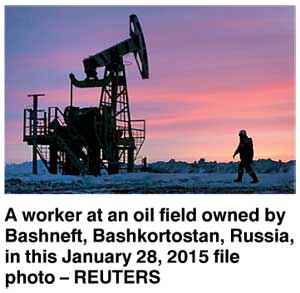Monday Dec 08, 2025
Monday Dec 08, 2025
Tuesday, 3 May 2016 00:01 - - {{hitsCtrl.values.hits}}
Singapore/Kitakyushu (Reuters): Oil prices fell on Monday as rising production in the Middle East outweighed a decline in the U.S. output and a sliding dollar, while Morgan Stanley warned that an emerging gasoline glut could also spill back into crude markets.
Brent was trading at $46.90 per barrel at 0643 GMT, down 47 cents, or 1%, from its last settlement. U.S. crude was down 33 cents at $45.59 a barrel.
Liquidity was low due to May Day holiday in many countries.
Analysts said rising output from the Organization of the Petroleum Exporting Countries (OPEC) was outweighing a decline in the  U.S. output and a sliding dollar, which makes it cheaper for countries using other currencies to import dollar-traded fuel.
U.S. output and a sliding dollar, which makes it cheaper for countries using other currencies to import dollar-traded fuel.
“The weaker dollar failed to excite investors in the crude oil markets,” ANZ bank said, citing a rise in OPEC-output as the main downward driver for prices.
The dollar has fallen over 6% this year against a basket of other leading currencies, but traders said the weak greenback and falling U.S. output had been priced into the market during April’s price rally.
OPEC supplies rose to 32.64 million barrels per day (bpd) in April, from 32.47 million bpd in March, according to a Reuters survey. That almost matches January’s 32.65 million bpd, when Indonesia’s return to OPEC boosted production to the highest, since at least 1997.
Russia, the biggest exporter outside OPEC, increased crude for seaborne exports to 3.117 million bpd in April, from 2.903 million bpd in March. Morgan Stanley said there is also a threat to crude prices coming from an emerging gasoline glut.
“Asia is the hub of a growing gasoline challenge. A growing product glut could lead to (refinery) run cuts later this year. We see a growing risk to refinery demand for crude oil,” the U.S. bank said.
Despite this, the chief of the International Energy Agency (IEA) said oil prices may have bottomed out, providing the health of the global economy does not pose a concern.
“In a normal economic environment, we will see the price direction is rather upwards than downwards,” IEA Executive Director Fatih Birol said on Sunday during a G7 meeting of energy ministers in Japan. Non-OPEC output is set to fall by more than 700,000 bpd this year, the biggest decline in around 20 years, he said.
With global oil demand seen growing by 1.2 million bpd this year, the draw in global stockpiles will start soon, helping push up prices, he said.
U.S. energy secretary Ernest Moniz said on Monday, at the same event in Japan, that U.S. oil production would likely fall 600,000 bpd this year, compared with 2015 when output peaked around 9.6 million bpd.